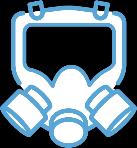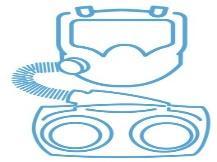






The new Model Work Health and Safety Regulations (Crystalline Silica Substances) Amendment 2024 require that control measures to eliminate or minimise risks are implemented so far as is reasonably practicable, and at least 1 of these measures are used:
• isolation of a person from dust exposure,
• a fully enclosed operator cabin fitted with a high efficiency air filtration system,
• an effective wet dust suppression method,
• an effective on-tool extraction system, and
• an effective local exhaust ventilation system.
If a person is still at risk of being exposed to respirable crystalline silica after 1 or more of the above measures are used, the person must be provided with Respiratory Protective Equipment and must wear it while the work is carried out in order for the Crystalline Silica Processing (CSP) to be considered controlled (Reg 529B).
Respiratory protection in Australian workplaces is normally carried out under the guidance of Australian/New Zealand Standard AS/NZS 1715:2009 “Selection, use and maintenance of respiratory protective equipment”. This requires use of AS/NZS 1716 compliant respirators under the direction of a respiratory protection program.
A comprehensive Respiratory Protection Program (RPP) in accordance with AS/NZS1715 Section 2 is needed to deal with the following issues to establish and confirm ongoing worker protection.


Respirators come in different designs, sizes, features and formats. The local work conditions and workers’ needs will have a direct effect on which type/s may be suitable for your workplace and processes.
For silica dust exposures, a particulate filter respirator (rated P2 or P3) is require. If exposures are high, more protection may be necessary up to Powered Air Purifying Respirator (PAPR) with a high assigned protection factor. In AS/NZS1715, this is called the required minimum protection factor (RMPF).
RMPF is the protection factor required to reduce exposure to an acceptable level. It is a measure of the level of respiratory protection of a type of respirator achievable when used correctly by a trained wearer. A RMPF of 10 equates to at least a 10-fold exposure reduction, compared to not wearing a respirator, for a trained worker. RMPF of 50 equates to at least a 50-fold exposure reduction. The higher the RMPF of a specific respirator, the more protective it should be against silica particles and for the wearer.
To calculate the RMPF, divide the worker exposure (obtained from personal exposure monitoring by the Workplace Exposure Standards (WES) for airborne contaminants.
Example for silica:
Worker’s exposure monitoring result = 0.3mg/m2
WES for Crystalline Silica (quartz) = 0.05mg/m3
0.3 / 0.05 = 6
Required Protection factor = 6
Suitable RMPF from the table below = 10 or more
If there is no respiratory protection expertise in your workplace, specialized help can be found from a consulting occupational hygienist or Respiratory Protective Equipment (RPE) manufacturers and suppliers. Further information in AS/NZS 1715 available from Standards Australia or a RESP-FIT fit tester .


P2 Disposable Half Face Reusable Full Facepiece PAPR - loose fitting hood




Protection Factor
RMPF up to10 RMPF up to10 with P2 or P3 filters
Lightweight, disposable, relatively comfortable, inexpensive. No cleaning or maintenance required.
Requires clean shaven wearer, face fit test needed, some breathing resistance. One size/model does not fit all. No protection given against gases and vapours.
Models without exhalation valves can become uncomfortable
RMPF up to 50 with P2 filters, RMPF up to 100 with P3 filters
Lightweight, offers protection against many contaminants, reusable, easy to clean.
Available in various sizes.
Protects the eyes, face from irritants, mists, flying particles. Available in various sizes.
Requires clean shaven wearer, face fit test needed, some breathing resistance
Requires clean shaven wearer, face fit test needed, some breathing resistance Heavier and less comfortable than half face.
Require special insert for eyeglass users.

RMPF up to 50
Provides protection and comfortable air to the wearer. Can be used by persons with facial hair. No added breathing resistance.
More expensive to purchase and maintain. Restricted to battery life. Implications of added weight and connection to waist mounted battery/fan must be assessed.
Note: Respirator combinations with RMPF greater than 50 are available. Contact a consulting occupational hygienist or RPE manufacturers and suppliers for further guidance.


Workers who are required to wear respiratory protection should have an initial medical assessment to ensure that they are able to cope with additional physical or psychological demands. Physiological and psychological considerations can include some serious conditions such as cardiac or respiratory disorders and claustrophobia. Individuals with medical conditions which make them unsuitable to wear tight-fitting negative pressure respirators may be offered a positive pressure, powered or supplied air respirator as an alternative. Refer AS/NZS 1715 Section 6.
There is nationally approved crystalline silica training available from training.gov.au that must be provided to workers at risk of exposure to crystalline silica. Workplace training may need to be specific to respirator use for those workers involved in Crystalline Silica Processes (CSP). What respiratory protection training should cover is detailed in AS/NZS1715 Section 7 and may be supplied by the suppliers of the respirators or suitable safety professionals Training may need to be more comprehensive for the powered respirators providing higher level of protection.

A tight-fitting respirator (positive or negative pressure, disposable or reusable) should be able to seal properly on the wearers face to provide the required levels of protection. In accordance with AS/NZS 1715, wearers of tight-fitting respirators such as a P2 disposable or reusable respirators should be trained in the correct way to wear their respirator and be fit tested before the first use and at least annually thereafter Fit testing is the method which demonstrates that the selected respirator provides an adequate seal for the individual’s size and face shape. A small percentage of people will not pass a fit test, so it is important that workers involved in CSP are known to have passed a fit test with their selected respirator. Fit testing can be done in-house by competent staff with the right testing equipment or via a service provider with this expertise. AIOH recommends using competent fit testers such as RESP-FIT accredited fit testers.


An adequate seal is required for a respirator to provide the assigned protection factor. This requires wearers to be clean shaven each time respiratory protection is worn. Tight fitting respirators should not be used by people who are not clean shaven. The complete sealing surface of the respirator should be in contact with the wearer’s skin.
To comply with AS/NZS 1715 wearers must be clean-shaven in the area of the seal when wearing a tight-fitting respirator. The alternative is loose fitting PAPR which can be used by persons with facial hair.
Wearers of respiratory protective equipment should be trained on cleaning and maintenance requirements in accordance with manufacturer's instructions to ensure that equipment is hygienic and operable. Reusable respirators should be inspected before and after each use and during cleaning to identify damaged or malfunctioning equipment. Refer to AS/NZS 1715 Section 9.
Non-maintainable P2 respirators are intended to be individual issue and discarded after use.
It is not uncommon for engineered and human controls to become less effective over time, so it is important to evaluate the effectiveness of any RPP on an ongoing basis for example by checking key performance indicators such as:
• Are higher order controls such as extraction ventilation and enclosures performing as per their design specifications?
• Are the respirators provided still adequate for protection and operational requirements?
• Are respirators readily available to all workers who need them?
• Are respirators being worn correctly on all occasions they are required?
• Are respirators wearers clean shaven?
• Are there records of training and fit testing?
This type of RPP evaluation service is typically based on AS/NZS1715 is commonly available from a reputable RPE supplier and/or occupational hygienist. Refer to Appendix D of AS/NZS 1715 for a more detailed checklist for a RPP evaluation.


In addition to RPE, disposable protective coveralls may be required when handling CS to mitigate secondary inhalation risk from dusty work clothes. If required, these coveralls should meet the EN ISO 13982-1 Type 5 standard for inward leakage.